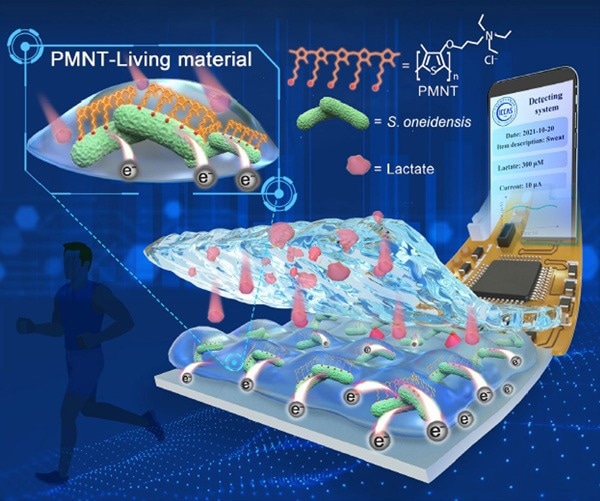Reviewed by Alex SmithJun 29 2022
With the revolutionary advancements in science and technology, the need for real-time human health monitoring is of significant relevance.
 Schematic diagram of PMNT-based living material and bioelectronic device for monitoring lactate in physiological fluids (sweat, urine, and plasma) and counting tumor cells. Image Credit: Zenghao Wang
Schematic diagram of PMNT-based living material and bioelectronic device for monitoring lactate in physiological fluids (sweat, urine, and plasma) and counting tumor cells. Image Credit: Zenghao Wang
For a better analysis of the state of human health, a research team from the Institute of Chemistry of the Chinese Academy of Sciences (ICCAS) developed a living substance for lactate monitoring in real-time.
In addition to being a key analyte in bioprocess engineering, sports medicine, and the clinical care setting, lactate is a trustworthy biomarker for the development, metastasis, and recurrence of tumors.
Real-time health monitoring can benefit from portable biosensors with high performance for determining the amount of lactate in bodily fluids for medical purposes and cancer treatment.
A novel biohybrid material called “living materials” combines biological components including bacteria, mammalian cells, fungus, and algae with synthetic functional materials. Thanks to their combined advantages, living materials are useful for biosensing, biosynthesis, and biomedical diagnostics.
The delocalized electrical structure of conjugated polymers (CPs) permits electron transport along the backbone.
Many new water-soluble conjugated polymers (WSCPs) with outstanding water-solubility, photoelectric property, and biocompatibility were developed and synthesized by further modifying the CP backbone utilizing water-soluble side chains.
The development of living materials and bioelectronic devices is anticipated to benefit from using WSCPs as good artificial functional materials.
The ICCAS team, led by professors Shu Wang and Haotian Bai, created a living material using Shewanella oneidensis MR-1 and cationic polythiophene (PMNT). The PMNT can help S. oneidensis MR-1 develop biofilms and improve the bioelectronic process.
As a result, the created living materials can hasten lactate oxidation and increase the rate of outward electron transfer.
Through additional functional module integration and engineering technology processing, the material is used to create a flexible bioelectronic device for lactate detection in physiological fluids (sweat, urine, and plasma) and tumor cells.
The portable smartphone could wirelessly receive and process all the electrical signals the flexible bioelectronic device had collected.
The method for creating living materials described in this study integrates the biological activity of live cells with the optoelectronic characteristics of CPs. Future uses for tracking one’s own health might be found in the flexible and wearable electronic gadgets based on the new living materials.
Journal Reference:
Wang, Z., et al. (2022) Flexible bioelectronic device fabricated by conductive polymer–based living material. Science Advances. doi:10.1126/sciadv.abo1458